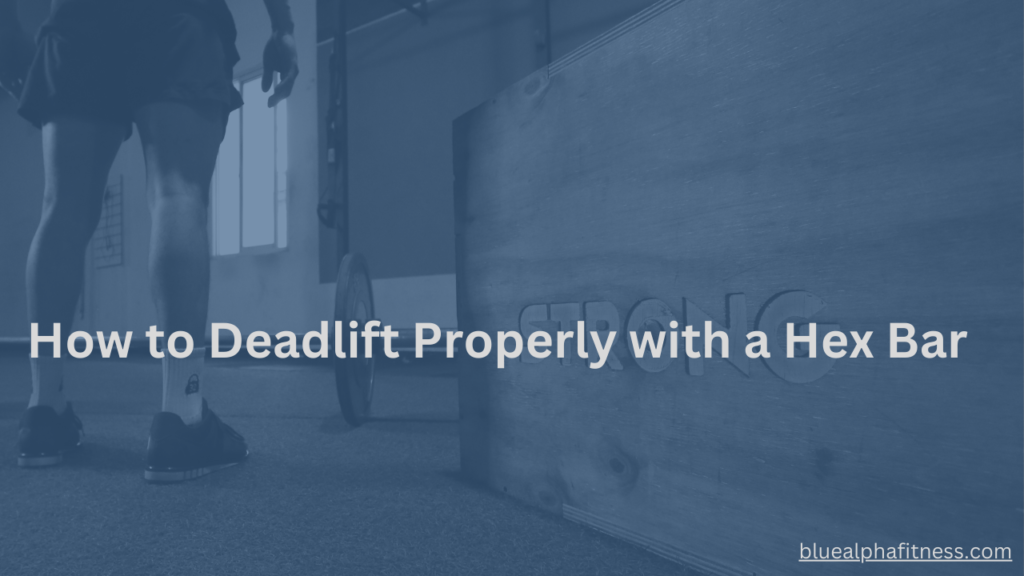Ever stood in front of a hex deadlift bar, feeling that nagging doubt creep in? “How heavy is a hex deadlift bar?” Your hands hover hesitantly, the question lingering as you second-guess whether to even attempt the lift. That uncertainty can shake your confidence in an instant.
It’s frustrating, isn’t it?
You just want to get stronger, to crush those goals, but not knowing the weight throws a wrench in your plans.
So, how heavy is a hex deadlift bar? Most hex deadlift bars weigh between 45 and 70 pounds. It might not seem like much, but knowing the exact weight can make or break your workout.
It’s not just about lifting; it’s about lifting wisely. That’s exactly what this guide is here to help with
We’re diving deep into everything you need to know about hex deadlift bars—weight, usage, tips, and more.
Ready? Let’s begin.
How Heavy is a Hex Deadlift Bar? Insights and Details
As mentioned earlier, the weight of a hex deadlift bar typically ranges from 45 to 70 pounds. This variation helps accommodate different lifting needs, whether you’re a beginner or an experienced lifter.
Knowing the specific weight of your bar can significantly impact your routine and allow you to tailor your lifting to your goals.
· Hex Deadlift Bar Weight Range: What You Need to Know
Hex bars aren’t one-size-fits-all.
Some are designed for beginners, while others cater to experienced lifters who require more robustness.
Lighter bars, around 45 pounds, are common in home gyms, making them widely accessible.
Heavier bars, approaching 70 pounds, are built for durability and strength, ideal for those who frequently push their limits.
· Impact of Material and Design on Hex Deadlift Bar Weight
The difference in weight among hex bars often results from the materials and design.
High-quality steel adds weight and durability, making the bar feel solid and unyielding. In contrast, lighter materials in cheaper bars can affect longevity.
Additionally, bars with thicker handles or complex designs generally weigh more, subtly influencing your lifting experience.
· Hex Bar vs. Standard Barbell: Weight Comparison and Benefits
If you’re used to a standard straight barbell, the hex bar might initially feel bulkier.
A straight bar typically weighs 45 pounds, so a heavier hex bar will be noticeable.
However, the hex bar’s design redistributes weight, making lifts feel more stable and natural. Many lifters find they can lift more with a hex bar due to its ergonomic design.
· How to Choose the Right Hex Deadlift Bar Weight for Your Goals
Selecting the right hex deadlift bar weight is crucial for meeting your lifting goals.
For beginners or those focusing on endurance, a lighter bar allows you to practice proper form without excessive strain.
Conversely, if you’re aiming for strength gains, a heavier bar presents a greater challenge and helps push your limits.
Think of it like choosing the right pair of shoes—comfort and fit matter just as much as performance.
· How to Accurately Measure the Weight of Your Hex Deadlift Bar
To measure the weight of your hex deadlift bar accurately, follow these steps:
- Weigh Yourself Alone: Use a bathroom scale to weigh yourself without the bar.
- Weigh Yourself Holding the Bar: Next, weigh yourself while holding the bar.
- Calculate the Bar’s Weight: Subtract your weight from the total weight to find the bar’s weight.
- Handle Large Bars: If the bar is too large for the scale, balance it carefully to ensure accurate measurement.
This method provides the precise weight, helping you track progress and adjust your workouts effectively.
Understanding how heavy your hex deadlift bar is helps you make informed lifting decisions, allowing you to train with confidence and efficiency.
How to Choose the Right Hex Deadlift Bar
Choosing the right hex deadlift bar involves evaluating factors such as weight, handle position, build quality, and knurling.
Whether you’re a beginner or an advanced lifter, selecting a hex bar that matches your strength level, lifting goals, and comfort needs is crucial for optimal performance and durability.
Below are the key factors to consider when choosing a hex deadlift bar:
1) Weight and Size
Firstly, consider your current strength level and your goals. If you’re a beginner, a lighter bar might be best.
If you’re more advanced, you might prefer a heavier bar that can handle more weight.
2) Handle Position
Some hex bars come with dual handle heights. These allow you to choose a higher or lower starting position, which can be a game-changer depending on your flexibility and the type of lift you’re doing:
- High handles are great for reducing the range of motion, making it easier on your back.
- Low handles are perfect for those looking to push their limits with deeper lifts.
3) Build Quality
Just like you wouldn’t buy a cheap wrench for tough jobs, the same applies to hex bars.
Look for bars made from durable materials with solid welds and finishes. A high-quality bar will last longer and perform better.
4) Knurling
Knurling refers to the texture on the handles that aids in grip. The right amount of knurling is crucial:
- Too rough can feel like sandpaper.
- Too smooth makes it hard to maintain a firm grip.
Find a bar with knurling that feels comfortable and secure for your hands.
Top Picks for Hex Deadlift Bars: Find Your Perfect Fit
When choosing a hex bar, consider these top brands:
- Rogue Fitness: Known for robust, well-designed bars highly regarded in the lifting community.
- CAP Barbell: Offers affordable yet reliable options, ideal for home gyms.
- Titan Fitness: Provides quality bars with diverse features to match various lifting styles.
How to Achieve Maximum Results with a Hex Deadlift Bar: Pro Tips
To get the best results with a hex deadlift bar, follow these pro tips: use your equipment correctly, warm up properly, maintain perfect form, and apply progressive overload.

The strategies below ensures that you maximize your training effectiveness and strength gains.
Tip 1: Know Your Equipment
Before you lift, take a moment to weigh your hex bar. Use a bathroom scale if needed.
To weigh it accurately:
- Place the bar on the scale and note the weight.
- If it’s too big for your scale, weigh yourself holding the bar and then subtract your body weight from the total.
This accuracy allows you to calculate your total lifting load precisely.
Additionally, be aware of the different types of hex bars (e.g., open-ended vs. closed-ended) and how they might affect your lifting.
Knowing the exact weight and type of your bar prevents missteps and ensures consistency in your training.
Tip 2: Warm Up Properly
Imagine this: your muscles are like cold rubber bands. If you stretch them without warming up, they might snap.
Warm up with dynamic stretches and light cardio to get the blood flowing.
Try these exercises:
- Jumping Jacks: Perform 2 sets of 30 seconds. Jump your feet out to the sides while raising your arms above your head, then return to the starting position.
- Leg Swings: Perform 2 sets of 10 reps per leg. Stand on one leg and swing the other leg forward and backward like a pendulum, keeping the movements controlled.
- Arm Circles: Perform 2 sets of 15 reps in each direction. Stretch your arms out to the sides, keeping them straight, and start making small, controlled circles. Gradually increase the size of the circles, feeling the movement engage your shoulders and arms with each rotation.
- Hip Circles: Perform 2 sets of 10 reps in each direction. Place your hands on your hips and make circular motions with your hips, first clockwise, then counterclockwise.
- Walking Lunges: Perform 2 sets of 10 reps per leg. Take a step forward with one leg and lower your hips until both knees form a 90-degree angle. Push through the front heel to return to the starting position, then repeat with the other leg.
These activities get your heart rate up and muscles ready for action.
A proper warm-up primes your body, reducing the risk of injury and making each lift safer and more effective.
Tip 3: Perfect Your Form
Maintaining proper form is crucial for effective and safe lifting. Here’s a step-by-step guide to help you keep perfect form during a hex deadlift:
1. Stance: Feet shoulder-width apart, toes slightly pointed out.
2. Grip: Use a neutral grip, holding the handles firmly.
3. Starting Position: Hips back, chest up, shoulders over the bar, and back straight.
4. Movement Pattern: Drive through your heels, keep the core engaged, and lift the bar by extending your hips and knees simultaneously.
5. Finishing Position: Stand tall with shoulders back and squeeze the glutes at the top.
Proper form maximizes efficiency and minimizes the risk of injury, allowing you to lift heavier and longer.
Common cues for proper form include “keep your chest up” and “push through your heels.”
Tip 4: Progressive Overload
Progressive overload is the key to building muscle. Gradually increase the weight you lift each session.
It’s like climbing a staircase; you take it one step at a time.
Add small increments of weight, such as 2.5-5 pounds each week, ensuring your form remains solid. Listen to your body and adjust increases based on your recovery and performance.
This method challenges your muscles, promoting growth and strength without overwhelming your body.
Consistent, gradual increases help you break through plateaus and keep your progress on track.
Tip 5: Incorporate Accessory Exercises
A well-rounded workout routine is like a balanced diet—it keeps everything in check.
Incorporate accessory exercises like Romanian deadlifts, leg presses, and back extensions. These exercises target supporting muscles, enhancing your overall deadlift performance.
- Romanian Deadlifts: Help build hamstring strength.
- Leg Presses: Develop your quads.
- Back Extensions: Strengthen your lower back.
Think of them as the side dishes that complement your main course. They help build strength in areas that support your primary lifts, leading to more balanced muscle development and better lifts.
Tip 6: Track Your Progress
Keep a detailed workout log, noting weights, reps, sets, and any notes on form or difficulty.
This log is your personal roadmap, showing where you’ve been and where you’re headed. It helps you see patterns, track progress, and adjust your training plan as needed.
For example, if you notice your progress stalling, it might be time to tweak your routine. You can use apps or tools to help with tracking progress.
A log provides valuable insights, helping you stay motivated and focused on your goals.
Tip 7: Rest and Recover
Muscle growth happens during rest, not while lifting. Ensure you get adequate sleep, proper nutrition, and take rest days.
Aim for 7-9 hours of sleep each night to boost recovery. Focus on a balanced diet rich in protein to aid muscle repair.
Also, incorporate active recovery methods such as stretching or light activity on rest days.
Rest is like recharging a battery; it keeps you going strong. Skimping on rest can lead to burnout and injuries.
Prioritize recovery to support muscle repair and growth, ensuring you come back stronger and ready for your next workout.
How to Deadlift Properly with a Hex Deadlift Bar
To deadlift properly with a hex deadlift bar, focus on maintaining a secure grip, using a neutral spine, and driving through your heels.
Ensure your feet are shoulder-width apart for stability, and engage your core throughout the lift.

These techniques help you lift safely and effectively, maximizing performance while minimizing injury risk
· Grip Tips
A secure grip is crucial.
Use chalk or lifting straps if necessary. Chalk helps keep your hands dry, providing a better grip.
Lifting straps can take some of the strain off your hands, letting you focus on the lift itself. Think of them as tools to enhance your performance, not crutches.
· Stance and Positioning
Maintain a neutral spine and keep your feet shoulder-width apart. Your stance is the foundation of your lift.
A neutral spine protects your back, while a shoulder-width stance offers stability.
Imagine planting your feet firmly into the ground like roots of a tree, providing a solid base for your lift.
· Lifting Technique
Drive through your heels and engage your core throughout the lift. This technique ensures you’re using your entire body efficiently.
Picture pushing the ground away from you with your heels, using your legs and core to lift the weight. This approach maximizes power and minimizes injury risk.
Safety Tips When Deadlifting Using a Hex Deadlift Bar
To lift safely with a hex deadlift bar, prioritize proper footwear, use lifting belts for back support, and avoid overtraining.
These key safety tips help ensure effective and injury-free deadlifting. Here are the essential safety practices to follow:
1. Proper Footwear
Wear flat-soled shoes to maintain stability.
Imagine it as constructing a house on a strong foundation. Flat soles provide better contact with the ground, improving balance and control.
2. Use of Lifting Belts
Consider wearing a lifting belt to support your lower back. A belt acts like a brace, providing additional support and stability.
It helps maintain proper form, especially during heavy lifts.
However, don’t rely on it too much. It’s a tool to assist, not a crutch to compensate for poor form.
3. Avoid Overtraining
Pay attention to your body and refrain from pushing through pain. Overtraining is like running a car engine without oil—it’ll break down eventually.
Recognize the difference between muscle soreness and pain. Soreness is a sign of muscles adapting and growing, but pain can indicate injury.
Rest when needed and avoid overexerting yourself. Consistent, mindful training leads to sustainable progress.
How Heavy is a Hex Deadlift Bar? Frequently Asked Questions
Now, let’s address some common questions about hex deadlift bars
1) How do you measure the weight of a hex deadlift bar?
You can measure the weight of a hex deadlift bar using a scale.
2) Can you use a hex bar for squats?
Yes, you can use a hex bar for squats, offering a more neutral grip and different muscle engagement.
3) Is a hex bar better for beginners?
Yes, a hex bar is often better for beginners as it reduces the strain on the lower back and helps maintain proper form.
4) How does lifting with a hex bar differ from a straight bar?
Lifting with a hex bar centers the weight, reducing stress on the spine and often allowing for a more comfortable and safe lift.
5) What muscles does the hex bar deadlift target?
The hex bar deadlift primarily targets the glutes, hamstrings, quadriceps, and lower back muscles.
6) Is the hex bar deadlift easier than the straight bar deadlift?
Yes, many lifters find the hex bar deadlift easier due to the neutral grip and balanced weight distribution.
7) Can you lift more with a hex bar than a straight bar?
Yes, most lifters can lift more weight with a hex bar compared to a straight bar because of the ergonomic design and balanced load.
8) How do you choose the right hex bar?
To choose the right hex bar, consider factors like the bar’s weight capacity, handle height, and knurling. Reputable brands include Rogue, Titan Fitness, and CAP Barbell.
9) What are the benefits of using a hex bar?
Benefits of using a hex bar include reduced lower back strain, improved form, and the ability to lift heavier weights safely.
10) How often should you use a hex bar in your workouts?
You should use a hex bar as often as your program requires, which can vary from once a week to multiple times depending on your goals and recovery.
11) Can using a hex bar help improve your deadlift performance with a straight bar?
Yes, using a hex bar can improve your overall strength and form, which can translate to better performance with a straight bar deadlift.
Wrapping Up Your Hex Deadlift Bar Journey
You’re probably thinking, “Do I have all the information I need to get started?” Absolutely, you do!
Feeling overwhelmed by the plethora of choices and technical details is totally normal.
But remember, every seasoned lifter started exactly where you are now—curious, motivated, and maybe a bit uncertain.
Imagine walking into the gym, hex bar in hand, and knowing you’ve got the knowledge to use it effectively.
You’re not just lifting weights; you’re lifting yourself to new heights of strength and confidence.
This article has armed you with crucial insights about the hex bar’s weight, selection tips, and pro strategies to enhance your performance.
You’ve learned how to choose the right bar, perfect your form, and integrate progressive overload to smash your goals.
Keep pushing, stay disciplined, and remember the benefits you’re reaping: reduced injury risk, better form, and impressive gains.
Now, go out there and own your lifts.
You’ve got this!



